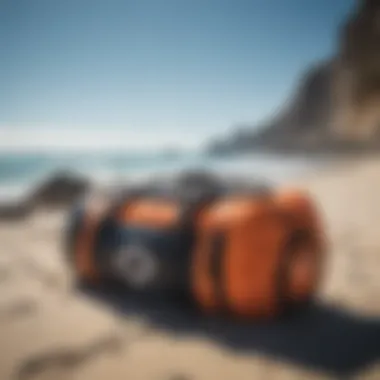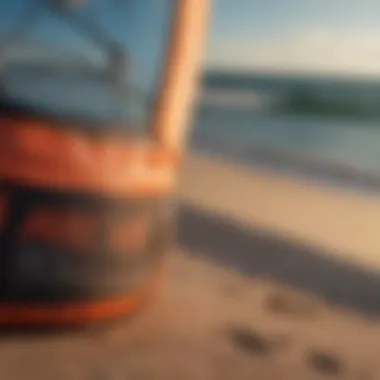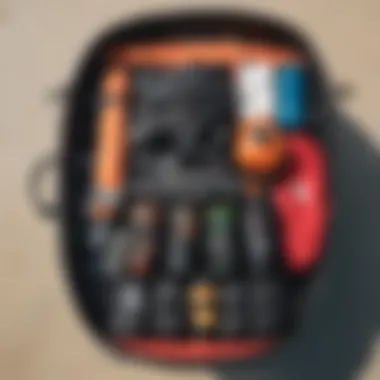Maximize Your Kiteboarding Gear with Compression Bags


Intro
Kiteboarding is not just a sport; it's a lifestyle that demands careful attention to gear, equipment, and how one organizes them. Kite compression bags have emerged as an indispensable tool for both enthusiastic newcomers and seasoned riders alike, thanks to their unique designs and functionality. They serve a dual purpose—optimizing storage and simplifying travel with your kiteboarding gear.
In a world where space is often at a premium and the adventure awaits, understanding the utility of kite compression bags can elevate your experience on the water. These bags are crafted with specific features tailored to protect and manage essential gear, ultimately making your kiteboarding excursions more seamless and enjoyable.
But what exactly makes these bags so beneficial? Let’s peel back the layers and dig into the details. To appreciate their value, we must first explore the gear and equipment involved in kiteboarding, then we’ll unravel techniques and tips that can maximize their utility.
Prelude to Kite Compression Bags
Kite compression bags play a pivotal role in the world of kiteboarding, offering both functionality and convenience. As the popularity of this dynamic sport continues to soar, understanding the utility of specialized gear becomes increasingly important. When kiteboarders embark on their adventures, the ability to pack efficiently can make or break the experience. Herein lies the importance of maximizing space while safeguarding equipment against unforeseen conditions during travel. As one prepares for a day on the water, selecting the right kite compression bag can reduce the stress of packing and improve overall efficiency.
Definition and Purpose
Kite compression bags are specifically designed storage solutions, primarily used by kiteboarding enthusiasts to minimize the bulk of their gear. These bags compress air out of the fabric, allowing for a more compact storage option, which is crucial for those constantly on the move. The goal is simple yet effective: protect and organize equipment while optimizing space. By employing a compression mechanism, these bags significantly reduce the volume of kites, harnesses, and lines, making them easier to transport.
The purpose extends beyond mere storage. Kite compression bags help to keep gear safe from environmental threats. Whether it's splashes from the ocean, UV rays, or even dust and dirt, a quality compression bag offers a robust barrier. Most are constructed with materials aimed at resisting moisture and abrasive elements, so the integrity of the gear is maintained over time.
Historical Context in Kiteboarding
The journey of kite compression bags traces back to the early days of kiteboarding, when gear was often cumbersome and difficult to transport. During this period, kiteboarders sought ways to make their adventures more manageable. In those days, large duffle bags and simple tarps were the norm, leading to a chaotic experience at beaches or wind conditions that required quick mobility.
As the sport matured, so did the gear. Innovators recognized the need for efficient packing solutions, which led to the development of compression bags. This evolution has been guided by feedback from the community, as kiteboarders expressed challenges with handling large quantities of equipment. The adoption of specialized materials and design features helped align the function of these bags with the unique demands of kiteboarding. Over time, the adoption of kite compression bags solidified their role as essential gear, allowing enthusiasts to enjoy the sport with less hassle.
Key Features of Kite Compression Bags
Kite compression bags have become increasingly important in the kiteboarding community due to their ability to enhance gear management. When you're out on the water, the right bag can make a significant difference in how you organize and transport your equipment. These bags keep everything from kites to harnesses neatly tucked away, ultimately leading to a better experience on the water.
Material Composition
When it comes to kite compression bags, the composition of materials plays a crucial role in performance, longevity, and user satisfaction. Understanding how different materials contribute to the functionality of these bags can help practitioners choose the right one for their demands.
Nylon Versatility
Nylon serves as one of the most popular materials for kite compression bags. It's light yet strong, making it a favored choice among kiteboarders and outdoor enthusiasts alike. The key characteristic of nylon is its excellent balance of weight and durability.
What sets nylon apart is its adaptability; it can be used in various weather conditions without compromising performance. The unique feature here is its ability to withstand typical wear and tear without showing significant signs of damage. However, one downside is that, depending on the quality, some nylon can be prone to tears if caught on sharp objects.
Hydrostatic Resistance
Hydrostatic resistance is another vital feature when assessing kite compression bags. This aspect deals with how well a bag can resist water pressure, which is essential when kiteboarding. A bag with good hydrostatic resistance keeps your gear dry, even in wet conditions.
The standout trait of bags with hydrostatic properties is that they can effectively protect moisture-sensitive equipment from unexpected showers. Therefore, having this capability is particularly beneficial for kiteboarders who often encounter unpredictable weather. A downside, however, could be the added weight such materials might bring, so the balance between protection and ease of transport needs consideration.
Durability Factors
Durability is a hallmark of a good kite compression bag, and it encompasses various aspects—from stitching quality to material resistance to wear. The remarkable feature of durable bags is that they are designed to withstand intense conditions, whether it’s being tossed around in a vehicle or enduring saltwater exposure.
The appeal of durability lies in the assurance it provides; kiteboarders can rest easy knowing their gear is well protected. However, the challenge is that more durable materials can occasionally be stiffer and heavier, which might affect packing ease. It's a balancing act that every kiteboarder has to consider when making their choice.
Design Innovations


The design elements of kite compression bags are equally important as material composition. Innovations in design have led to bags that not only perform well but also meet the specific needs of users. The future of kiteboarding gear management lies in these innovative designs.
Streamlined Shapes
Streamlined shapes are an essential feature of modern kite compression bags. These designs help minimize bulk while maximizing storage efficiency. A key characteristic here is that such shapes allow for easier packing and transport, as they fit snugly into vehicle compartments and travel gear.
The advantage of streamlined shapes is that they take up less space and make navigating through tight spots a breeze. However, depending on the design, it might lead to limitations in the volume of gear one can store, so practicality always needs to be assessed.
Weight Distribution
Proper weight distribution is crucial in kite compression bags, particularly for those who are carrying them over long distances. An even distribution of weight prevents strain on the back and shoulders, enhancing comfort during transport. This makes it a favored feature among those who often travel or hike with their gear.
One unique aspect of effective weight distribution is how different compartments are designed to hold heavier items, keeping the center of gravity lower. But a downside to consider is that overly complex designs could reduce the ease of access to gear when time is of the essence.
Ventilation Mechanisms
Ventilation mechanisms in kite compression bags serve an important purpose, preventing moisture buildup inside the bag. By allowing air to circulate, these designs help keep gear fresh and dry, particularly after usage in humid or wet environments.
A key characteristic of such mechanisms is that they help reduce odors and mold growth, increasing the longevity of the equipment stored inside. However, integrating ventilation can sometimes weaken the bag's water resistance, creating a trade-off that users have to navigate.
Kite compression bags are a vital part of gear management, combining material and design innovations to meet the needs of kiteboarders and outdoor enthusiasts.
The Functionality of Compression in Kite Gear Management
When we dive into the realm of kiteboarding, we realize that managing gear is as crucial as the excitement of hitting the water. The right tools can either make or break your experience. Kite compression bags emerge as indispensable allies in this task. Not only do they help in keeping your equipment organized, but they also serve functionality in several ways. Here, we’ll explore the various aspects of compression styles that help kiteboarders better manage their gear.
Space Optimization Techniques
Air Volume Reduction
One of the standout features of kite compression bags is the ability to reduce air volume. This might sound basic, but it's super important. By squeezing out excess air, you maximize the space available for other essentials—think about packing extra snacks or an additional hoodie! Reducing air aids in lowering the bag's overall size, which can be a game-changing characteristic when you're juggling multiple bags pre-flight, or even just tossing gear into the back of a car.
The unique aspect here is the design of these bags. They create a vacuum environment which serves as a protective cocoon around your kite gear. This leads to effective space management while ensuring minimal bulk. Maybe the biggest disadvantage? Higher pressure settings can lead to stress on bag seams. So it always pays to check those dimensions every once in a while.
Layering Strategies
Next, we tackle layering strategies that form the backbone of effective packing. Layering allows you to arrange items in a way that not only optimizes space but also grants easier access once you’re at your destination.
Consider the notion of putting lighter items on top and heavier ones below; this helps with weight distribution, making it easier to carry. Additionally, some kite compression bags come with internal compartments, allowing one to act akin to a Tetris game—with the added bonus of knowledge that you won’t have a jumble to contend with when you reach the beach.
The downside? It requires some initial planning, but once you get the hang of it, it becomes second nature.
Tight Packing Essentials
Tight packing is another essential aspect to consider when using kite compression bags. This concept involves filling every nook and cranny, ensuring there’s no wasted space. Tight packing can often lead to a more compact design, which can come in handy during travel. You might even discover more room in your trunk than you thought you had!
Unique to this packing method is the ability to create custom configurations based on your own needs. If you have multiple kites, you could easily fit them all by adjusting the layout. However, it might take some trial and error to find the optimal configuration for your particular gear set.
Protection Against Environmental Factors
Water Resistance
Another prominent feature is water resistance. Think of the scenarios you face—unexpected downpours or rogue waves. It’s comforting to know that your gear is protected from moisture intrusion. Most kite compression bags are built with waterproof materials that can withstand these elements.


The seller often highlights this characteristic as a key benefit, ensuring that kiteboarders can venture out without fretting about the weather. While adding another layer of security, note that it can also mean additional weight. It’s a trade-off of sorts; you gain security but might have slightly bulkier gear.
UV Shielding
Next on our radar is the concept of UV shielding. Kite gear is costly, and exposure to sunlight can degrade the materials over time. Bags equipped with UV protection can mitigate this factor. Beyond just a cosmetic concern, neglecting UV damage can impact performance during high-stakes kiteboarding.
Yet another bonus is the wide availability of this feature across different brands, meaning you can find a bag that suits your budgets and needs. Like any protective feature, the cost may reflect the level of extra shielding you receive. So it's important to weigh quality versus expense.
Impact Protection
Last but not least is impact protection. Kiteboarding gear is often subject to rough handling—from tight airport security checks to casual tosses in the backseat. Compression bags equipped with unique padding or reinforced covers can absorb shocks effectively, keeping your equipment in top shape.
While this is a huge plus, some bags might be a touch heavier due to these features. Careful selection of a bag that balances protection with weight is key here. It's about maintaining performance without sacrificing safety.
Selecting the Right Kite Compression Bag
Choosing the appropriate kite compression bag is pivotal for kiteboarding enthusiasts. It not only influences how you pack and transport your gear but also determines how well your equipment is protected during travels. The right bag ensures that your gear remains in excellent condition and is easily accessible when you need it. To make a sound decision, you need to consider a few factors that can significantly affect your overall experience on the water.
Size and Capacity Considerations
Volume Requirements
When discussing volume requirements, one must understand how vital it is to have enough space for all your equipment. A kite compression bag should accommodate your kites, lines, and accessories without being overly bulky. A bag that’s too small might lead to deformation of your gear, compromising its performance and longevity. An optimal volume requirement strikes a balance; it should be spacious enough to snugly fit your items while minimizing unnecessary air pockets.
The unique aspect about volume requirements is that they often dictate how you organize your gear. For instance, you may use smaller packing cubes for your lines and harness, allowing for more efficient packing while maximizing space inside the bag.
Weight Limitations
Weight limitations play a crucial role in selecting your kite compression bag, especially if you're flying to your destination. Many airlines have strict policies on sports equipment weights, and finding a lightweight bag that doesn’t skimp on durability is paramount. A lighter compression bag means less strain on your shoulders, and it can make handling your gear less of a chore.
However, one should keep in mind that ultra-lightweight materials might not always provide the needed protection. Therefore, it's necessary to strike a balance between weight and structural integrity. A clever choice in multifunctional materials can provide both lightness and strength, allowing kiteboarders to pack freely without exceeding weight limits.
Adjustable Options
Adjustable options in compression bags are also an essential aspect to consider. A model that offers adjustability in size allows you to customize the fit based on the volume of your gear every time you pack. This flexibility ensures that your kite compression bag is versatile for different trips.
Moreover, adjustable straps or expandable design features can contribute greatly to usability. When fitted correctly, these options prevent unnecessary movement of equipment during transit, which can be detrimental to fragile components. This adaptability ensures that kiteboarders can enjoy a secure and customized packaging experience, fitting a wide variety of gear without compromise.
Brand Comparisons
Reputable Brands Overview
When you’re in the market for a kite compression bag, it helps to know some reputable brands. These brands usually have proven track records and user trust. Notable names like Ocean Rodeo, Slingshot, and Crazyfly have garnered attention for their quality and reliability. They consistently deliver products that meet the robust demands of kiteboarders. Purchasing from reputable brands often translates to better warranty options and reliable customer service when needed.
Each brand may slightly differ in design philosophy and targeted features, which can impact facility and protection. Knowing which brands prioritize material quality, waterproofing, or anti-tear properties can also guide choices that align with your specific requirements.
User Reviews and Feedback
User reviews offer an invaluable perspective when selecting a kite compression bag. Real-life testimonies can shed light on aspects that may not be evident through marketing promotions. These insights help potential buyers gauge the pros and cons of different options available in the market.
Prospective users often share experiences regarding durability, ease of use, space optimization, and how the bag held up in various environmental conditions. Consistently positive reviews regarding a particular model may indicate its reliability, while repeated complaints about a specific issue would similarly highlight potential weaknesses.
Cost-Effectiveness


Cost-effectiveness is also a relevant topic when choosing a kite compression bag. While it might be tempting to opt for the cheapest option, it’s essential to consider long-term value instead. Higher-priced products often come with advanced materials and better design which can provide durability over time.
Conversely, finding reasonably priced options with adequate quality can lead to substantial savings without sacrificing important features. Evaluating whether the cost aligns with the offered features, warranty, and user feedback can help ensure the bag is worth every penny spent.
Understanding these elements will ultimately help kiteboarders not only in optimizing their travel but also in preserving their valuable gear.
Maintenance and Care for Kite Compression Bags
Kite compression bags are invaluable tools for enthusiasts looking to safeguard their gear. By ensuring proper maintenance and care, users can prolong the lifespan of these bags while ensuring their equipment is kept in top-notch condition. Let’s delve into the essential aspects that one should consider.
Cleaning Protocols
Keeping your kite compression bag clean is not just about aesthetics; it plays a crucial role in maintaining the integrity of the bag. Dust, saltwater, and sand can significantly affect the bag’s quality over time. A regular cleaning routine can prevent material degradation and ensure maximum performance.
For basic cleaning, a mix of warm water and mild soap is often sufficient. It’s best to use a soft cloth or sponge to avoid scratching the fabric. Ensure you rinse the bag thoroughly to eliminate any soap residue, which could potentially harm the material. Avoid using harsh chemicals or abrasive tools, as they can wear down the specialized coatings many bags have for water and UV resistance.
After cleaning, allow the bag to air dry completely before storing it. This way, you avoid potential mildew or mold growth, which could arise from damp conditions. With these simple cleaning protocols, the lifespan of your kite compression bag can be extended considerably.
Storage Practices
Proper storage of kite compression bags is key to maintaining their functionality. Where and how they are stored can make a world of difference.
Humidity Control
Humidity plays a significant role in preserving the quality of kite compression bags. Excess moisture in the environment can lead to mold and mildew growth, which not only damages the bags but also can compromise the gear inside. Maintaining a dryness level is beneficial for both the storage environment and the bags themselves.
One effective approach is using silica gel packs, which can absorb excess moisture within the bag or storage area. This unique feature makes silica gel a popular choice, especially for those living in humid climates. While they are not foolproof, they offer a practical solution to humidity control, enhancing overall care routines.
Safe Environment Conditions
Creating a safe environment for storing kite compression bags means considering factors that can influence their structure and effectiveness. Extreme temperatures and direct sunlight can degrade materials over time. Ideally, bags should be stored in a cool, dry place away from harsh elements.
One key characteristic of this practice is stability. Keeping your bags in a consistent environment without drastic changes protects the integrity of the materials used. While this may seem daunting at first, investing the time to establish proper storage conditions will yield significant benefits, preserving your kite equipment for many seasons to come.
"The best way to ensure longevity for kite compression bags is through careful cleaning and thoughtful storage practices, taking into account both humidity control and safe environment conditions."
Closure
In reviewing the utility and benefits of kite compression bags, it becomes evident that these items serve as essential gear for any kiteboarding aficionado. They are not merely bags; they are a testament to the blend of functionality and convenience. Every kiteboarder knows the heartache of packing away limp kites and tangled lines. Compression bags minimize that headache by organizing gear in a way that’s effective yet unobtrusive. This article aims to deepen the understanding of compression bags, their design, material selections, and the role they play in enhancing the kiteboarding experience.
Recap of Key Insights
- Space Optimization: Kite compression bags offer significant space savings, allowing for efficient packing of large kite sets without the bulk. This is particularly valuable when traveling.
- Material Durability: Understanding the materials that make up these bags is crucial. The nylon used in kite compression bags is not just sturdy; it’s lightweight and resistant to water damage. This keeps the gear safe from the elements.
- Design Benefits: The design is not just aesthetic. Streamlined designs facilitate easy transport, while weight distribution balances the load, making it easier to carry to remote beaches.
- Air volume reduction techniques help pack kites tighter.
- Layering strategies for secure fitting of various pieces of equipment.
- Tight packing essentials that every kiteboarder should know for a neat setup.
- Hydrostatic resistance ensures gear stays dry, while UV shielding extends the life of kites being stored.
- Ventilation mechanisms play a vital role in preventing moisture build-up in the bags, safeguarding your equipment from mold and decay.
This summary encapsulates the primary advantages of kite compression bags that can significantly enhance the kiteboarding experience, ensuring that every enthusiast can hit the waves without a worry.
Future Trends in Kite Compression Technology
As the kiteboarding industry evolves, so do the innovations in kite compression technology. The future looks promising with several trends on the horizon:
- Smart Bags: There is growing interest in integrating technology into compression bags, like sensors that monitor humidity and temperature.
- Eco-Friendly Materials: Manufacturers are shifting towards sustainable materials. Expect to see bags made from recycled plastics and other environmentally-conscious choices.
- Advanced Design Features: Expect further innovations in design which may include modular systems, allowing kiteboarders to customize their compression bags based on personal preferences.
- Collaboration with Tech Companies: Innovative collaborations might emerge, blending outdoor gear with tech companies to create smarter, more functional bags.
In closing, the kite compression bag is expected to evolve continually, meeting the demands of both newbies and seasoned pros. By leveraging advancements in design and materials, kite compression bags will enhance organization and protection for kiteboarding gear while paving the path for enhanced experiences on the water.















